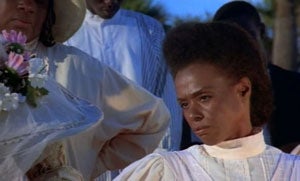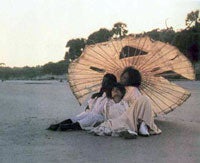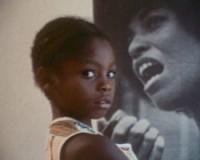As a first-time viewer of Daughters of the Dust, I am blessed that my first encounter with it was through this newly restored print. According to viewers and members of the cast and crew—including Ms. Dash herself—at Friday’s screening, this was the best the film has looked in years. The advantages of this new, fully-timed second answer print should be apparent to all fans of beautiful images. Most striking to me was the film’s use of indigo blue, an element surely diminished in previous versions that were not fully-timed.
Indigo blue is arguably the impetus for the entire film, as the original West African inhabitants of St. Helena stayed to work the indigo. The film’s dual narrators—who work to connect the past and future—weave the color throughout in their costuming: the blue ribbon in the Unborn Child’s hair mirrors Nana Peazant’s indigo dress. During the film, Nana sews an indigo charm, known as a “hand,” containing locks of her mother’s and her own hair, which she gives to her granddaughters to take to the mainland.
It is significant that Nana gives her daughters a “hand” because of what her own hands, dyed blue from working the indigo, have already done for them. Nana’s hands are surely on Eula’s mind when she speaks of scars: “We carry too many scars from our past. We wear our scars like armor, for protection. […] Let’s live our lives without living in the fold of old wounds.”
Ultimately, Nana, Eula and the Unborn Child ask the Peazant family to stop running from the scars that, like the dye in Nana’s hands, cannot be washed away. The motif of indigo blue underscores the idea that the past, though painful, is indelible, and must be embraced in order to welcome the future.
—Jenni Fong
Bibliography/Further Reading:
Alexander, Karen. “Daughters of the Dust: Julie Dash Talks About African American Women’s Cinema and Images from Her Film.” Sight and Sound 3, no. 9 (1993): 20-23.
Dembrow, Michael. “Daughters of the Dust.” Cascade Festival of African Films #15. March 7, 2005. Accessed October 08, 2011.
I have vivid memories of my great grandmother who raised me covering over hair that had been disposed in the garbage, always keeping a bible near the bed where we slept, spraying “good luck” air freshener all around the house. Her traditions in my African American family were a mix of religion and superstition, so I thought. After watching Daughters of the Dust, I know now those traditions may have represented much more.

Daughters of the Dust tells the story of the Gullah people, descendents of the Ibo Africans who were brought to America as slaves to the isolated Sea Islands off the South Carolina-Georgia coast. The family still lives there more than 50 years after slavery, still holding the traditions of their African ancestors close to their hearts. Well, that’s the case for some of the family. The other family members feel bogged down by the old and have their sights set a new life in the North—where their dreams and hopes lie, the place where they’ve heard true freedom can be found. A few family members who made the exodus to the North years earlier have come back to get the rest, and that’s the point of the story when African tradition clashed with the newfound Christian religion in this family. This is a battle we see them fight throughout the film.
I couldn’t help but reflect on my own experience growing up in a home with guardians several generations older than me. I cannot attribute any one of my family’s traditions as a religious one versus an African one. Some may have come from my great grandmother’s grandparents who were slaves. Some I’m guessing came from the white family they worked for in the South. And some my great grandparents created when they migrated from the South to Chicago. No matter the origin, these traditions are solid in my memory and a few have even survived and are active in my life today. Julie Dash’s Daughter of the Dust has given me new perspective on these customs. When I was a girl, they seemed archaic, regressive and downright annoying. Now, they represent footprints of the past and are nuggets of my cultural makeup. And although I cannot say where specifically my people are from in Africa, I now clearly see that I still carry a piece of them in my life today. I have Julie Dash and Daughters of the Dust to thank for that enlightenment.
—Felischa Marye

If you’d asked me last week what I knew of the Gullah culture and people, I would have been hard pressed to come up with something intelligent to say. But not a day later after having seen Julie Dash’s Daughters of the Dust for the first time, all I can think about is the once popular children’s show, “Gullah Gullah Island.” This seems a particularly childish association on my part, but Daughters of the Dust is all about memory, and being a child of the '90s, I remember “Gullah Gullah Island.” What stands out most prominently in my mind about my childhood exposure to Gullah culture through children’s programming are the songs, bright colors, and an enormous yellow polliwog named Binyah Binyah. In the style of Nickelodeon Television, everything was bright, playful and fun. And while any connection made between Daughters of the Dust and “Gullah Gullah Island” seem almost a disservice to the progressive achievements and seriousness of Julie Dash’s film, I was surprised to find myself making those connections. Like Daughters of the Dust, “Gullah Gullah Island” possesses a very lyrical quality to its dialogue, peppering what is presumably Gullah language throughout the show. In fact, Julie Dash made a clear connection to “Gullah Gullah Island” during the panel discussion following the screening when she said that Ron Daise had worked with the cast of Daughters of the Dust on the Gullah dialect, the same Ron Daise who, with his wife, created and starred in “Gullah Gullah Island.” So perhaps such connections should be made, and I am eager to revisit the show to discover other ways in which it enriches and departs from my experience with Daughters of the Dust.
—Rachel Wilson






 Mobile Navigation
Mobile Navigation

